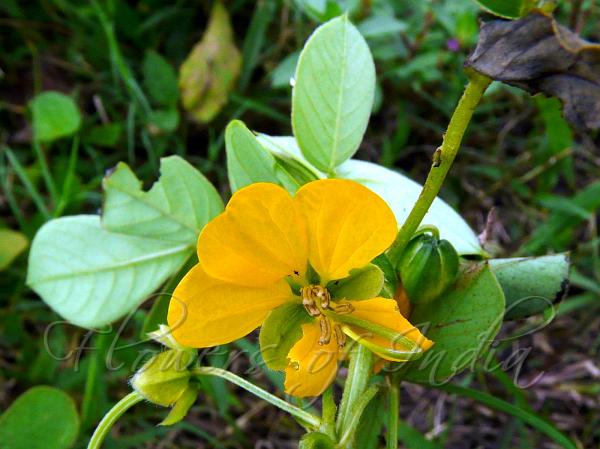|
| Stinking Cassia |
|

|

| File size | 338569 |
| Original date | 5/30/19 10:43 AM |
| Resolution | 1400 x 1050 |
| Flash | Flash did not fire, auto |
| Focal length | 4.6mm |
| Exposure time | 1/200s |
| Aperture | 5.0 |
| Focus Distance | |
| Metering Mode | Spot |
| Camera make | Panasonic |
| Camera model | DMC-FZ18 |
| Sensor type | OneChipColorArea |
|
|
|
|
Photo: |
Botanical name: Senna tora Family: Caesalpiniaceae (Gulmohar family)
Synonyms: Cassia tora
Synonyms: Cassia tora
Stinking Cassia is a small erect hairlesss shrub, about 1 m tall, commonly
found growing wild on roadsides. True to its name, foetid/stinking cassia
has a disagreeable smell. It is widely spreading with numerous ascending,
hairless branches. The compound leaves are arranged spirally and usually
have three pairs of symmetrically egg-shaped leaflets up to 2 inches long.
One to three yellow flowers appear on short axillary stems. The linear
pods grow to 8 inches long, curve downward and contain many shiny, angular
seeds. It occurs abundantly in open pastures, and is very common on
roadsides and wasteland. In organic farms of India, Stinking Cassia is
used as natural pesticide. Stinking Cassia is native to Central America,
widely naturalized in the Tropical World. Flowering: December-May.
Medicinal uses: According to Ayurveda, the leaves
and seeds are useful in leprosy, ringworm, flatulence, colic, dyspepsia,
constipation, cough, bronchitis, cardiac disorders.
According to Ayurveda, the leaves
and seeds are useful in leprosy, ringworm, flatulence, colic, dyspepsia,
constipation, cough, bronchitis, cardiac disorders.
Medicinal uses:
 According to Ayurveda, the leaves
and seeds are useful in leprosy, ringworm, flatulence, colic, dyspepsia,
constipation, cough, bronchitis, cardiac disorders.
According to Ayurveda, the leaves
and seeds are useful in leprosy, ringworm, flatulence, colic, dyspepsia,
constipation, cough, bronchitis, cardiac disorders. | Identification credit: Gurcharan Singh | Photographed in Arunachal Pradesh & Hoogly, Bengal. |
• Is this flower misidentified? If yes,